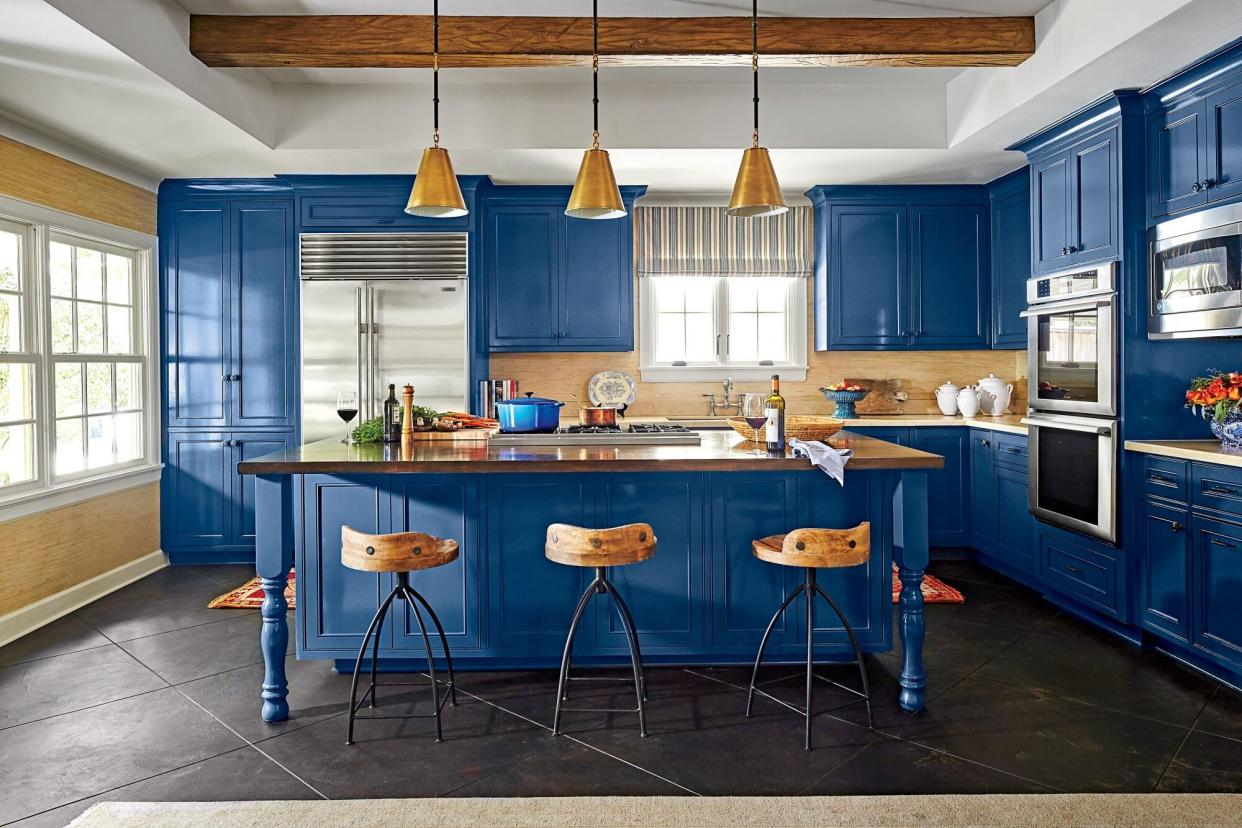When I Learned How to Clean Kitchen Cabinets, I Was Shocked by the Hidden Grime

Laurey W. Glenn; Styling: Adam Fortner
TABLE OF CONTENTS
On This Page
How Often Should You Clean Kitchen Cabinets?
What You'll Need
How I Cleaned My Painted Kitchen Cabinets
Tips for Wooden and Laminate Cabinets
I'm the kind of person who can't go to bed with a sink full of dishes. No matter how much effort it takes, I typically manage to pull myself away from the table and tackle it all–dishes, stovetop, countertop, and pans. It's soothing to know everything is in its place before a good night's sleep. It's because of that inherited sense of kitchen cleanliness that I'm writing this anonymously. I'm entirely in disbelief at the dirt my neglected kitchen cabinets have been harboring.
It started with a simple realization: The organization of my cabinets was not working for my household. The maze blocking our slow cooker was a weekly struggle, and don't get me started on how many water bottles one family can use. I knew I could reorganize my small kitchen to make it much more efficient. I didn't know that this would lead to a much more pressing task: a deep scrubbing of my cabinets. As stylish as my navy-blue cabinets are, they might be too good at hiding spills.
Whether your cabinets are wood, laminate, painted, or custom, I'm willing to bet yours could use a scrub too. Here's what you need to know to deep clean your kitchen cabinets.
How Often Should You Clean Kitchen Cabinets?
If you're in the kitchen often, daily cooking is coating your cabinets with grease and grime, whether you like it or not. To keep things clean, try to wipe the outside of your cabinets once a week. Deep clean the outside and inside every few months.
What You'll Need
Microfiber cloth or soft, clean rags
Toothbrush
Bucket
Warm water
Dish soap
Baking soda
Multi-purpose Cleaner
Kitchen gloves
Handheld vacuum cleaner (optional)
Soft cleaning eraser (optional)
Oil cleaner (for wood cabinets only)
How I Cleaned My Painted Kitchen Cabinets
Let's start with painted cabinets. For my cabinets, I used this article on Better Homes and Gardens as a jumping-off point and tailored the process to fit my space as I went along.
Clear the Way: It might seem daunting, but just do it. For deep cleaning, it's best to start with empty shelves. Clear your dishes, cups, and appliances from the shelves. I should have timed this with a full dishwasher to make it a little bit easier. Maybe you can learn from my mistake.
Pick the Right Cloth: Painted cabinets are sensitive, so avoiding abrasive cleaning tools is best. A soft cloth or clean rag will do the trick. I used a microfiber cloth.
Clean the Exterior: Grabbing my typical multi-purpose bottle with all the sprays stashed under my sink is tempting. But leaning on my research, I mixed warm water with a bit of dish soap to create a nice bubble bath for the painted exterior of my cabinets.
I wiped the outside of each, starting from the top and working my way down. I tried not to get the cabinets too wet since a damp cloth is best for drying painted cabinet areas. If you want to try an all-purpose cleaner, just test it on an inconspicuous spot before making a wipe you may regret.Spot Clean Grease: After a full round on my cabinets, a few grease stains remained (thank you, spaghetti night). To remove, I mixed two parts baking soda with one part warm water and rubbed the paste onto the remaining stains. I let it sit before wiping it away with a damp cloth and patting it dry.
Vacuum the Inside: It's incredible where crumbs can end up. A handheld vacuum was a quick solution for stray crumbs.
Wipe Down Shelves: After testing a multi-purpose cleanser on an out-of-site spot, I wiped down each empty shelf, working cabinet by cabinet. Be sure to wipe dry before moving on.
Scrub the Nooks and Crannies: This is the step where I could feel myself turning into my mother. Using an old toothbrush, I gently scrubbed the corners and crevasses inside each cabinet.
Give It a Final Dry and Replenish Shelves: Before putting all of my dishes away (hello, much-needed opportunity to reorganize my shelves!), I wiped down everything to make sure all surfaces were dry.
Tips for Wooden and Laminate Cabinets
While a few things vary by cabinet type, most of my process translates to wooden or laminate cabinets. Here are a few things to remember about other kinds of cabinets.
Wood Cabinets
Like painted cabinets, wooden cabinets need gentle cleaners. Use oil soap to clean and polish your cabinets with a microfiber cloth. Use damp cloths and wipe with the grain. Dilute oil soap with warm water and use a toothbrush to spot-treat stains.
Laminate Cabinets
All-purpose cleaners work fine on this hardier surface: mix baking soda and warm water for spot cleaning, similar to painted cabinets. You can also use a soft cleaning eraser to remove scuff marks on laminate cabinets.

